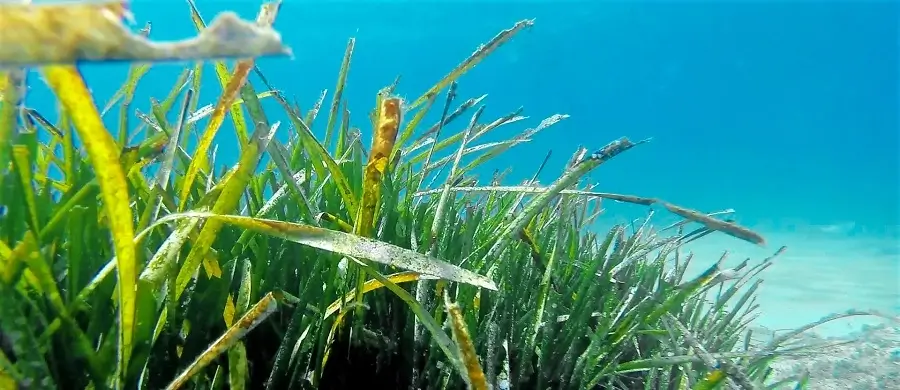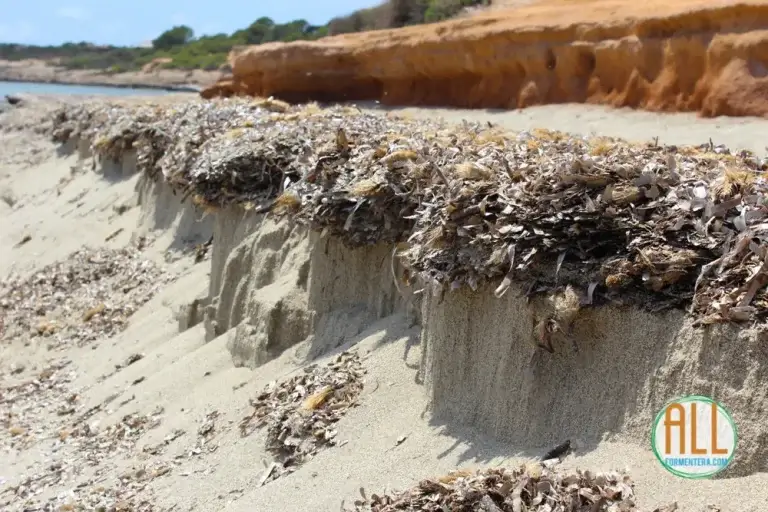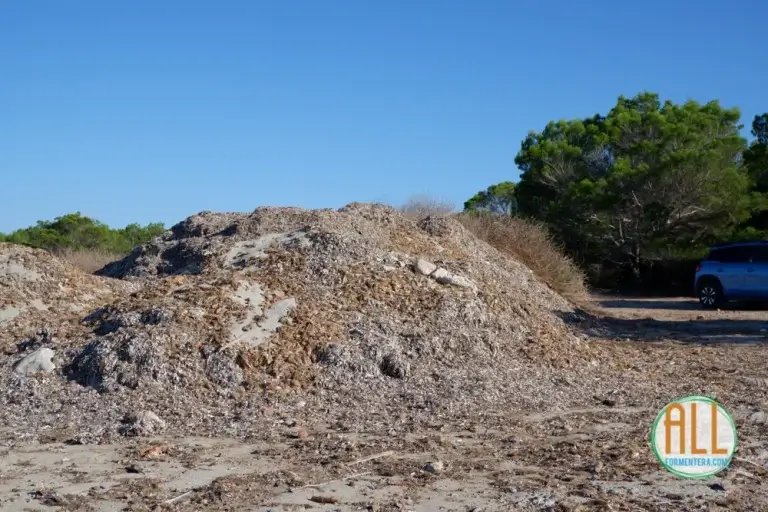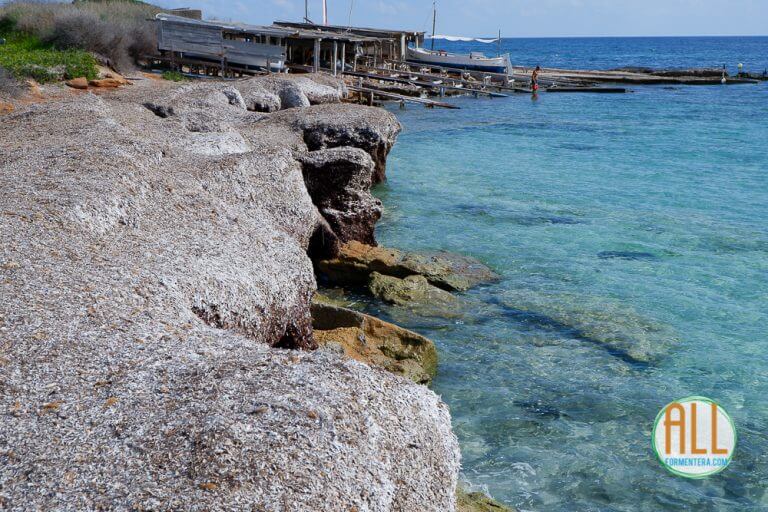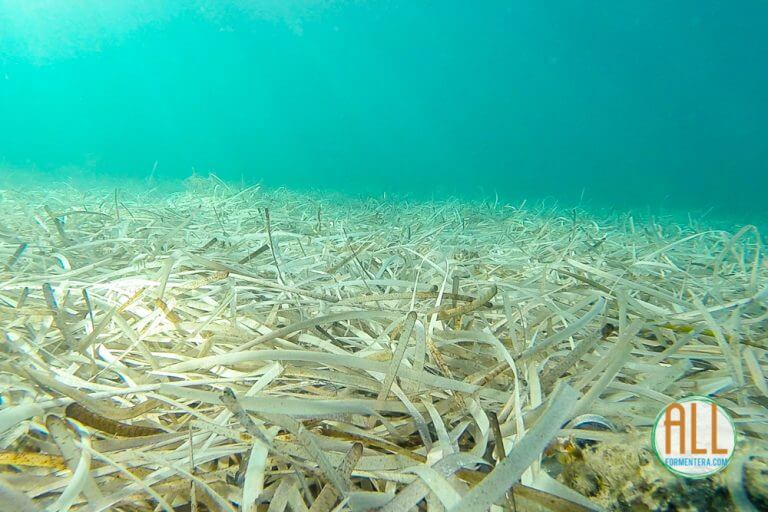The Posidonia of Formentera
If you presume to know all the secrets of the island of Formentera -or you are getting information to visit it- and you don’t know what the word Posidonia means, let us tell you that you still don’t know everything about Formentera.
In fact, you don’t know something very important for Formentera and its waters. Posidonia is closely related to the beaches of Formentera: we owe the beauty, clarity, clarity and spectacularity of the waters of the island to Posidonia.
Posidonia Oceanica: the star aquatic plant of Formentera, the Balearic Islands and the entire Mediterranean.

From now on, the name Posidonia must be engraved in your memory when you think of Formentera.
Posidonia is an aquatic plant that forms underwater meadows from the surface to 40 meters deep. At greater depths the amount of sunlight and energy reaching the seafloor is so weak that Posidonia usually cannot grow.
The Posidoniaceae family has only 9 species, some living as far away as the coasts of Australia. The 9 species of Posidonia identified are:
- Posidonia angustifolia
- Posidonia australis
- Posidonia coriacea
- Posidonia denhartogii
- Posidonia kirkmanii
- Posidonia oceanica
- Posidonia ostenfeldii
- Posidonia robertsonia
- Posidonia sinuosa
It is necessary to emphasize that Posidonia is not an alga but a superior plant, as are the thousands of species of aquatic plants existing on the planet, whether freshwater, saltwater, brackish, floating, semi-submerged or completely submerged.
The Posidoniaceae family is related to other families of saltwater submerged aquatic plants, with which they share appearance and characteristics, such as the Zosteraceae or Hydrocharitaceae families.
Characteristics of Posidonia Oceanica
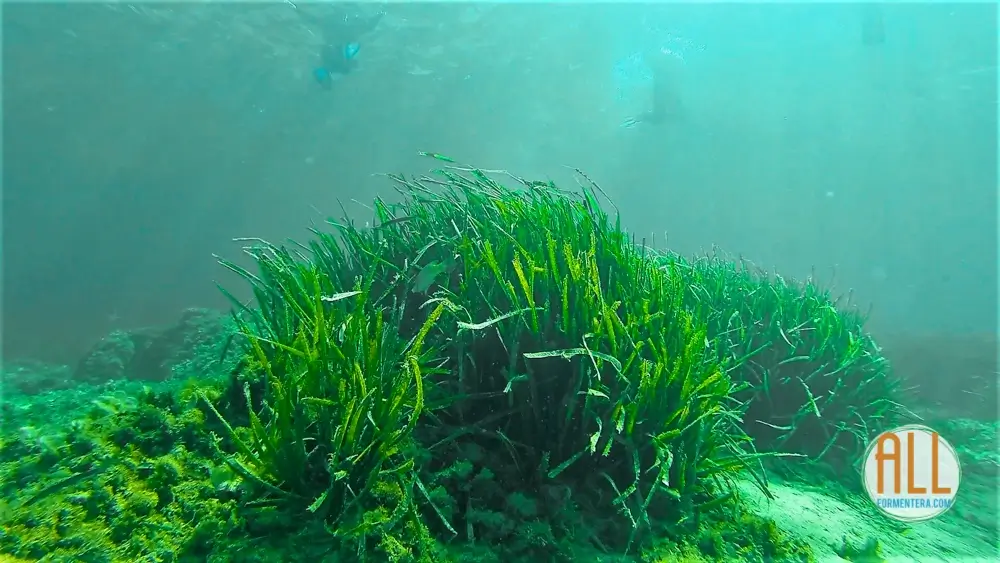
Posidonia is a terrestrial plant that has adapted to the marine environment, therefore it shares many similarities with plants as such, although it has modified its structure to be able to live anchored to the seabed.
Posidonia: an ancient organism
We know that Posidonia has an extremely slow growth (barely one centimeter per year) and that most of the meadows we see are several centuries old.
However, in 2006 a genetic study carried out in a Posidonia meadow between Ibiza and Formentera concluded that the entire meadow of more than 8 kilometers long was actually a single individual whose age could be around 100,000 years.
Can there be a living thing on the planet that is 100,000 years old? Yes, it is possible: the Posidonia genome is very resistant to mutations, and part of its way of reproducing is to create clones of itself indefinitely through the growth of the rhizome (the “trunk”).
Therefore, genetically we can state that it is the same plant that has been reproducing indefinitely for 100 millennia.
Plant parts
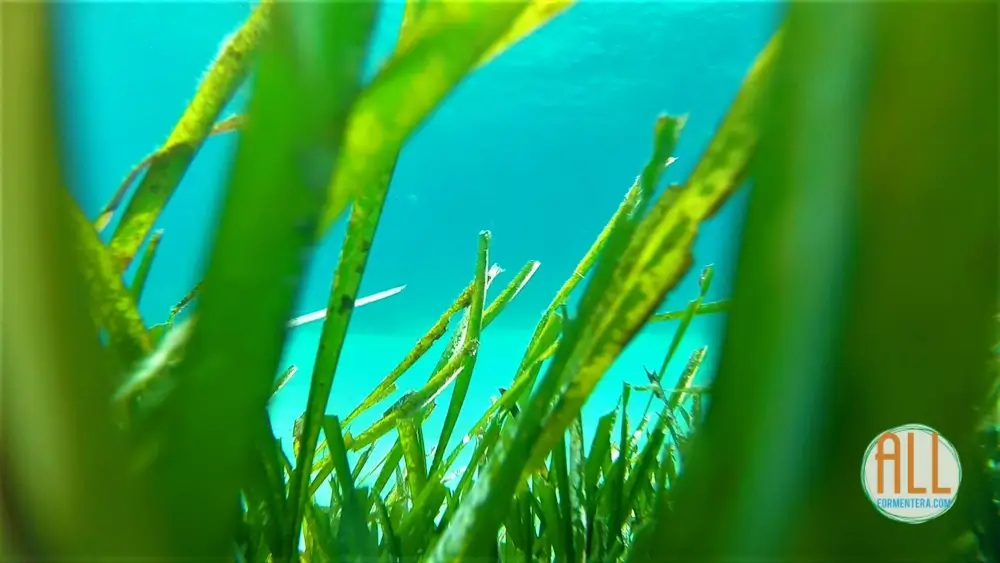
Posidonia is a submerged saltwater aquatic plant that grows by attaching itself to the seabed, preferring soft or sandy soil. We do not normally see it on rock unless the rock is porous or covered with mud or sand.
The rhizome
What we would define as the “trunk” of the plant is called the rhizome, and is the nucleus from which the roots develop downwards and the leaves upwards. The rhizome grows horizontally like a spider web, expanding semi-buried on the seabed, but it does so at an extremely slow rate: about 1 centimeter per year.
This means that to cover one square meter of sand by rhizome growth alone, Posidonia needs 20 to 50 years.
Leaves
Posidonia leaves are deciduous and the plant loses them when autumn arrives. They grow in spring from the rhizome, as ribbons between one and two centimeters wide and up to one meter long.
They have an intense green color during spring and early summer, turning dark green/brown as the summer progresses and the Posidonia is covered by algae, sponges and other marine organisms. The leaves die and the plant removes them in early autumn.
Flowers and seeds
Posidonia reproduces by rhizome growth, although it develops flowers and also multiplies by seeds. However, the number of seeds that germinate is low and the chances of being able to attach themselves to the seabed and not be washed ashore are very low.
As we can see, Posidonia, with the characteristics of its adaptation to the marine habitat, has stems and trunks, roots, develops flowers, changes its leaves and, like any plant, performs photosynthesis, capturing sunlight, carbon dioxide and nitrates dissolved in the water to combine them, obtaining food and releasing oxygen in the process.
Photosynthesis of Posidonia
Photosynthesis is the process by which plants with chlorophyll (terrestrial or aquatic) capture sunlight to convert carbon dioxide and water into carbohydrates that feed the plant and oxygen that is released into the atmosphere.
A very simple diagram of how photosynthesis works is as follows:
Carbon dioxide (CO2) + Water (H2O) + sunlight = Carbohydrates (CH2O) + Oxygen (O2).
The photosynthesis performed by Posidonia is extremely efficient: one hectare of Posidonia produces 5 times more oxygen than one hectare of rainforest.
To give you an idea, in the summer months, when Posidonia receives more hours of light, it releases 20 liters of oxygen per day… per square meter!
This in turn means that Posidonia is a great consumer and fixer of CO2, helping to combat climate change.
If you want to see live how a plant photosynthesizes and emits oxygen through its leaves, a good way is to observe a planted aquarium, where controlled water conditions and intense and adequate lighting make the plants produce oxygen at breakneck speed. This amount of oxygen produced by the plants is so great that the gas does not have time to dissolve invisibly in the water and creates bubbles that rise to the surface, turning the aquarium into something like a bubbling glass of champagne.
You can see this phenomenon in the following video:
The aquarium in the video above is about 20 liters, or 20 x 40 centimeters. Now imagine the thousands and thousands of hectares of posidonia seagrass meadows surrounding Formentera illuminated by the sun and you will understand that the amount of carbon dioxide consumed and oxygen released by these meadows into the water and air is of the order of several tons every day.
The life cycle of the plant

Posidonia, like the rest of the higher plants that exist on the planet, is sensitive to seasonal changes and throughout the year goes through different phases of growth, flowering, leaf loss and hibernation.
Autumn
When the water temperature and hours of sunlight begin to drop, Posidonia loses leaves that accumulate on the seabed near the meadows formed by the plant.
It is at this time when the arrival of dead leaves on the beaches of Formentera begins, with its characteristic dark brown color.
This is also the time when Posidonia blooms, with inconspicuous and inconspicuous flowers, usually hermaphrodite, which are fertilized in the water. The leaves that the plant loses are replaced at this time by new leaves, still in a very early stage, which have been forming during the summer months.
Winter
During the winter months Posidonia is practically in a dormant state, with growth halted due to lower water temperature and fewer daylight hours. During the most intense storms of the winter months is when the largest quantities of dead leaves arrive on the beaches, dragged from the seabed by the strong currents, accumulating on the shore and in the sand.
Spring
The plant starts to become active with the rise in temperature and the increased number of daylight hours. During this period the leaves grow exponentially until they reach lengths of about one meter.
If you have the opportunity to dive during the months of May-June, you will see that the Posidonia meadows have an intense green color and it is when the plant has a more lush and colorful appearance.
It is also in spring when the fruits that were fertilized in autumn germinate, moving aimlessly along the seabed to, at the slightest opportunity they have, develop roots and attach themselves to the seabed to create new plants.
Summer
During the summer months is when the maximum hours of sunshine and water temperature are reached, which translates into an explosion of marine life at all levels. For Posidonia this means that many marine organisms such as sponges, algae, bryozoans, primitive mollusks… adhere to its leaves, progressively limiting their capacity for photosynthesis and transforming the intense spring green color of the new leaves into a somewhat duller color, thus reducing the attractiveness of the meadows.
When autumn approaches those leaves fall off, the plant develops flowers and the cycle repeats itself.
Why Posidonia is the basis of the marine ecosystem of Formentera?

This simple-looking plant is the basis for the proper functioning of the marine ecosystem of Formentera and all shallow areas of the Mediterranean Sea. In fact, the life cycle of almost all animals living in the waters of Formentera are directly linked to the existence of this plant.
To begin with, the enormous amount of oxygen it releases into the waters where it grows contributes to more species of fish and invertebrates where Posidonia grows, which benefits divers eager to observe marine fauna and fishermen for whom the sea is their way of life.
This is ultimately key to local development, both for the tourism and leisure economy and for the primary fishing sector. Posidonia is also closely related to several very significant aspects of the waters of Formentera.
Posidonia helps to keep the water clean
Posidonia is responsible for Formentera’s clear, clean waters and exceptional visibility. This is achieved in three ways:
- Its roots and rhizome -just as tree roots do- fix the seabed, preventing erosion from waves and storms. In this way, the plant helps to ensure that, when water is stirred up by strong currents or storms, sediments that would remain in suspension in the water are not stirred up.
- Posidonia meadows create natural barriers and reefs that reduce the violent impact of water on the seabed and the coast, and are a brake on sea currents and storm surges.
- By consuming the nitrates dissolved in the sea, it helps to prevent algae from multiplying, thus avoiding the turbidity of the water due to algae growth. In fact, aquatic plants are the most direct competition of algae for the use of nitrates dissolved in the water, only that plants are more complex organisms and therefore much more efficient in the use and consumption of nitrates than algae.
Posidonia meadows are the habitat of many marine species.
Posidonia is also the basis of life for almost all the small marine species of Formentera. Just as forests are a complex ecosystem that harbors many species of plants and animals, posidonia offers the same in the seabed.
Animals use Posidonia in various ways:
- As food: several species of herbivorous fish, shrimps, shrimps, sea urchins, starfish… feed on Posidonia stems and remains.
- As a refuge: smaller species of fish and invertebrates hide among the stems to avoid predators. If we are attentive we can see various fauna hidden among the leaves, such as cuttlefish. Octopuses also find in the Posidonia rhizomes that are buried in the seabed thousands of holes where to settle, as well as several species of shrimp live camouflaged among its leaves. The star inhabitant of the Posidonia meadows is the seahorse.
- As a breeding site: many fish species use the dense Posidonia meadows as a place to fix and hide their eggs during the spawning season. When the fry hatch, they hide among the dense Posidonia where they are much more protected from dangers and sea currents than in the open sea.
- As a hunting ground: just as small fish use Posidonia to hide among its dense stems, predators use Posidonia as a hiding place from which to stalk those fish that are not cautious enough.
Posidonia is the basis of habitat for other organisms.
During the summer months the Posidonia leaves are covered with other organisms that grow during the months of higher solar intensity. If you dive in the waters of Formentera in late August or September you will see that the Posidonia meadows have lost their intense green color to a less colorful green, with shades closer to gray and brown.
This is because the leaves of the plant have been colonized by organisms such as hydrozoa, bryozoa, algae, etc.; organisms also related to the good health of the Mediterranean coasts and key to the proper functioning of the Mediterranean marine ecosystem.
Posidonia protects beaches from erosion
By creating reefs and meadows at shallow depths, Posidonia allows the water to reach the shore with much less force, without destroying the beach. In addition, during the autumn-winter months, when the water temperature begins to drop and the hours of sunshine in the northern hemisphere are reduced, the plant removes old leaves that will be replaced by new ones during the following spring.
All discarded leaves accumulate on the seabed and winter storms wash them onto beaches, where they can accumulate in large quantities. This accumulation of dead leaves on the surface of the beach creates a spongy blanket, sometimes several centimeters thick, and protects the beaches from storms by preventing the sea from carrying sand into deeper waters. Posidonia, thanks to its changing leaves, protects the beaches from erosion.
Gallery: oceanic posidonia accumulated on Formentera’s beaches or removed from them.
Dangers that threaten posidonia

Even knowing how important this plant is for the marine life and the coasts of Formentera and the whole Mediterranean, the most important plant of Formentera is endangered. Its most direct threats are several.
Climate change
According to studies carried out by the CSIC and several environmental organizations, the increase in water temperature causes the death of the plant and stops its growth, which can be a threat to its conservation.
However, a study conducted in 2017 by the Spanish Oceanographic Institute and several international agencies has found that increased water temperature induces plant flowering, which could compensate for some of the rhizome death with the production of a higher number of seeds, although more data are needed to see the impact of this phenomenon and whether the two factors actually compensate.
Anchoring of boats
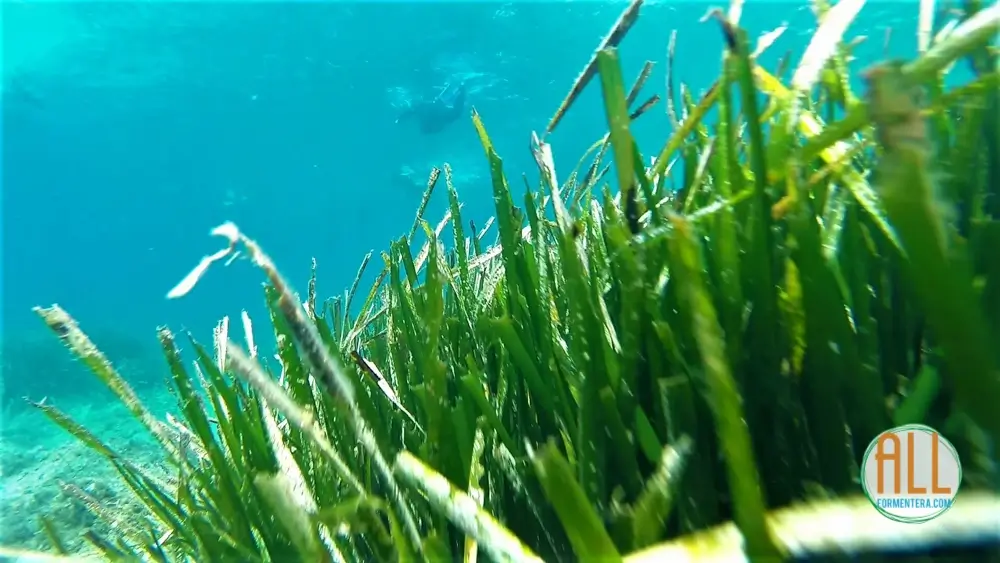
Currently, the anchoring of boats in the Posidonia meadows is the greatest threat. The anchors of recreational boats, some of them weighing more than 200 kilos and with several meters of heavy chains, pull up large quantities of Posidonia when the boat lifts anchors from the seabed.
The anchor of the ships acts on the prairie like a giant plow, tearing out several meters of prairie that take decades (or centuries) to recover. As we have said, Posidonia takes 20 to 50 years to cover one square meter of seabed, and every time a ship drags its anchor through a Posidonia meadow much more than one square meter is lost, on the order of several to be exact.
In addition, on a windy day, if the boat moves in circles on the surface, the anchor chain drags in circles on the bottom, tearing up even more meadow area. Although anchoring over Posidonia meadows is strictly forbidden, -it is easy to see from the surface whether the boat is on a sandy area or a meadow and decide whether to drop anchor or not- it is very difficult to control the anchoring of boats because of the limited manpower available.
The measures that have been implemented include the installation of fixed ecological buoys so that boats can anchor without damaging the seabed, and awareness and information campaigns. There are also financial penalties for repeat offenders, which can exceed €600 per vessel.
Invasive species

Caulerpa Taxifolia
is the name of a toxic alga that lives in tropical waters around the world. In Spain it has been listed as an Invasive Alien Species since 2013, as it constitutes a serious threat to native vegetation and algae, and therefore also to its associated fauna.
It arrived in the Mediterranean in 1984 when the Oceanographic Museum of Monaco decided to clean at sea several aquariums that had contained specimens of Caulerpa taxifolia and that is where the disaster started.
The coasts of France and northern Italy are the most affected, although it has also reached Croatia, the Balearic Islands, Alicante and Murcia. In its natural habitat, Caulerpa taxifolia does not form large colonies, since there are animals that feed on it and are therefore immune to its toxin. It also needs very specific conditions of light, oxygenation and temperature.
In the Mediterranean, however, it has no natural enemies and has evolved into what is almost a new species of Caulerpa, much more toxic, which withstands temperatures as low as 10ºC, resists several days out of water, has increased its size extraordinarily and can attach itself to sand, rock, sediments and almost any surface.
Caulerpa Taxifolia displaces the Posidonia meadows, eliminating them, causing the disappearance of all marine life associated with the Mediterranean aquatic plant par excellence. Although the presence of Caulerpa taxifolia has not been detected in Formentera, there are already colonies in Mallorca, so its arrival in the smallest of the pitiüsas, for example, fixed on the anchor of a boat, would not be a casual phenomenon.
Pollution and spills
Water pollution negatively affects Posidonia, which needs clean and clear water to thrive. In fact, the presence of Posidonia indicates that the marine ecosystem is perfectly healthy and in balance. Pollution and illegal dumping, in addition to seriously affecting marine life, cloud the water which hinders the plant’s photosynthesis and therefore causes its slow death and disappearance.
Protect Posidonia: you can also collaborate

If you want this marine plant to continue helping Formentera to have the beaches with the clearest and most spectacular waters of the Mediterranean, you can collaborate in several ways.
Spread the word
Inform your friends, acquaintances and family about the importance of Posidonia for Formentera and for all shallow coastal areas throughout the Mediterranean Sea. Explain to your friends that the accumulation of Posidonia on beaches is not a nuisance but a cycle that nature and the seas have been repeating for hundreds of thousands of years.
Anchor your boat responsibly
If you are going to enjoy a day sailing in Formentera or any other place in the Mediterranean, find out about the places where there are posidonia meadows before dropping anchor.Or simply jump into the water with a pair of goggles to watch the bottom and guide the captain when dropping the anchor. This will ensure that the anchor falls on rock or sand and not on a meadow, which would destroy several square meters of plant and rhizomes that will take hundreds of years to recover.
Sponsor hectares of Posidonia
Through the Save Posidonia Project launched by the Consell Insular de Formentera you can “sponsor” Posidonia at the ridiculous price of 1€ per square meter. This price is much cheaper than the cost of land on Formentera, but its value for the sea and marine fauna is certainly much higher.
Part of the seabed of Formentera is a UNESCO World Heritage Site since 1999 and it is our obligation as visitors, consumers of seafood and as responsible tourists to preserve it.
All proceeds raised by the Save Posidonia Project platform go to the conservation of these centuries-old seagrass meadows, through awareness-raising, direct action and conservation projects for this fragile marine ecosystem.
You have reached the end of the article. Other sites that may interest you are:
